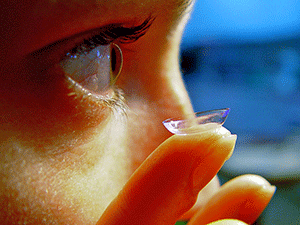If you wear contact lenses, you may feel like you need them to see well while swimming. Although being able to see properly may keep you from bumping into walls, wearing contacts while swimming can be dangerous in a number of ways.
In fact, getting your contacts wet with any sort of water — whether it’s in the pool, a lake, or the shower, can raise your risk of several types of eye issues.
Here’s a look at the risks of swimming while wearing contact lenses, and the steps you can take to protect your eyes while you’re in the water.
What are the risks of swimming while wearing contacts?
Although exposure to any type of water isn’t advised for contact lenses, swimming while wearing your contacts can be particularly dangerous due to the prolonged exposure. The lenses can absorb the water, trapping potential bacteria, viruses, or other pathogens against your eye.
 Additionally, swimming in lakes, rivers, and oceans may be more dangerous than swimming in a pool. That’s because natural bodies of water are more likely to contain different types of bacteria, viruses, and other harmful pathogens that may be killed by pool chemicals.
Additionally, swimming in lakes, rivers, and oceans may be more dangerous than swimming in a pool. That’s because natural bodies of water are more likely to contain different types of bacteria, viruses, and other harmful pathogens that may be killed by pool chemicals.
But that doesn’t mean that swimming in a pool while wearing your contact lenses is safe. Chlorine and other pool chemicals can’t kill all pathogens. Soft lenses in particular are porous, so pathogens and pool chemicals can still get into your eyes.
Wearing your contact lenses while swimming may raise your risk of the following eye issues:
- eye irritation due to lenses sticking to your eyes
- dry eye syndrome, especially when swimming in a chlorinated pool or salt water
- eye infections
- corneal abrasion or scratch
- eye inflammation (uveitis)
- corneal ulcers
Is it safe to wear contact lenses while showering?
Aside from sterile contact lens solutions, any type of water can be harmful if you get it in your eyes while wearing contact lenses.
The risk of showering while wearing contact lenses is similar to the risk of swimming while wearing your contacts. It raises your risk of numerous eye issues, including dry eyes, eye infections, and inflammation.
In addition, according to the Centers for Disease Control and Prevention (CDC)Trusted Source, there’s a type of amoeba called Acanthamoeba that can be found in all types of water, but it’s more common in tap water or well water, like you might use to shower.
This amoeba can cause a serious eye infection called Acanthamoeba keratitis. Acanthamoeba keratitis is painful and difficult to treat and, in rare cases, can lead to blindness.
If you need to shower with your contact lenses in, take them out as soon as you’re done showering. Then soak them in disinfecting contact solution for 24 hours.
Safety tips for swimming with contact lenses
If you can’t swim safely without wearing your contact lenses, there are some precautions you can take to reduce your risk of an eye infection. For instance, you can:
- Wear goggles. Any tight-fitting type of goggle will help keep water out of your eye. If you swim often, consider a pair of prescription goggles, so you won’t have to wear your contact lenses.
- Take your contacts out immediately after swimming. Then rinse your eyes with clean water and put on your glasses. Or, you can put in a new, clean pair of contact lenses.
- After swimming with your contacts in, disinfect your lenses in contact lens solution for 24 hours.
- Consider wearing daily contact lenses and throwing them away after swimming.
- Use artificial tears or rewetting drops before and after swimming to reduce the risk of dry eyes.
- If you swim competitively, talk to your doctor about a special type of rigid gas permeable contact lens that you wear at night to reshape your cornea. This can eventually lead to you not needing contact lenses during the day. You might also consider LASIK surgery to help correct your vision.
What are the symptoms of an eye infection?
If you swim or shower while wearing your contact lenses, be on the lookout for symptoms of an eye infection, which include:
- red eyes
- eye pain
- itchy eyes
- excessively watery, teary eyes
- blurry vision
- eye discharge
- swelling
- sensitivity to light
- feeling like you have something in your eye
If you have any of these symptoms after your contact lenses get wet, see your doctor. Early diagnosis is important for any eye infection.
The bottom line
Swimming or showering while wearing contact lenses may raise your risk of several types of eye issues, ranging from dry eyes to a serious eye infection. To reduce this risk, it’s usually best to avoid wearing contact lenses while you’re in the water.
If you have to wear your contacts while swimming or showering, take steps to protect your eyes. Consider wearing tight-fitting goggles, removing and disinfecting your contacts right after you get out of the water, or discarding them altogether.
Be sure to follow up with your healthcare provider if, after being in the water with your contact lenses, your eyes are red, irritated, painful, itchy, or excessively watery.
Sources:
- Is It Safe to Wear Contact Lenses While Swimming? September 14, 2020
Make your appointment today
To make your appointment, simply give us a call (760)-948-3345 or
or
Due to COVID-19 safety protocols, all eyewear services are currently by appointment only. Please call to make an appointment.
At Golden Eye Optometry, we view good vision care as front line protection at every age. A routine eye exam can detect more than poor vision. It can shed early light on glaucoma, macular degeneration, cataracts and diabetes.